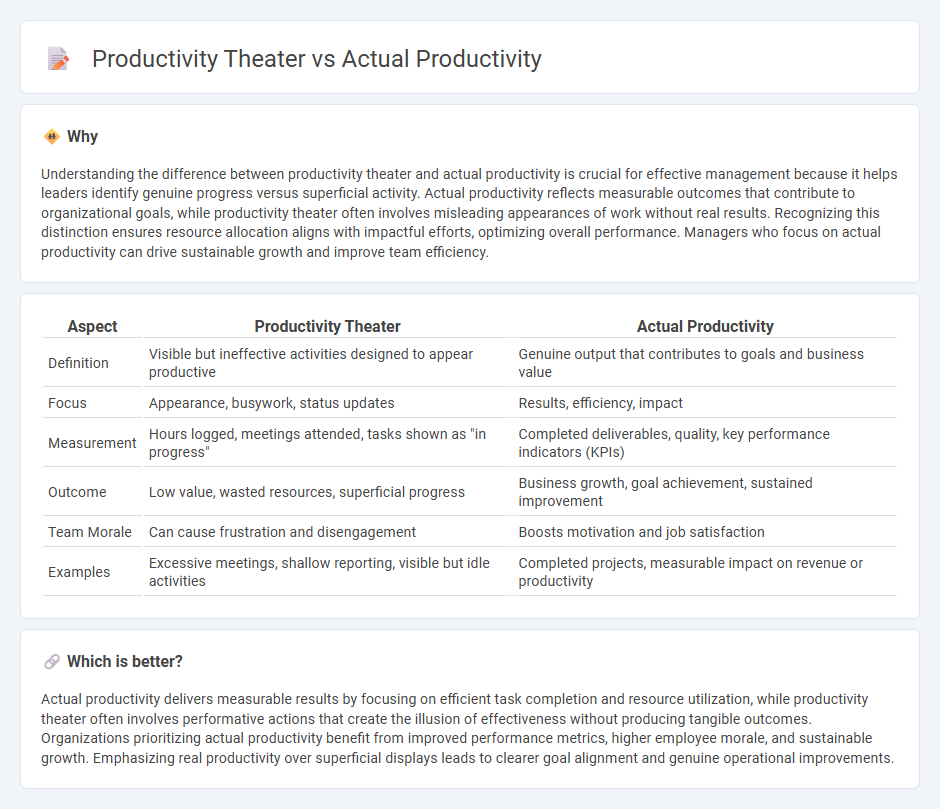
Management often faces the challenge of distinguishing between productivity theater--where activities create the illusion of progress--and actual productivity, which delivers measurable results. Metrics such as output quality, task completion rates, and goal attainment accurately reflect genuine performance. Explore effective strategies to enhance real productivity and minimize unproductive busyness.
Why it is important
Understanding the difference between productivity theater and actual productivity is crucial for effective management because it helps leaders identify genuine progress versus superficial activity. Actual productivity reflects measurable outcomes that contribute to organizational goals, while productivity theater often involves misleading appearances of work without real results. Recognizing this distinction ensures resource allocation aligns with impactful efforts, optimizing overall performance. Managers who focus on actual productivity can drive sustainable growth and improve team efficiency.
Comparison Table
| Aspect | Productivity Theater | Actual Productivity |
|---|---|---|
| Definition | Visible but ineffective activities designed to appear productive | Genuine output that contributes to goals and business value |
| Focus | Appearance, busywork, status updates | Results, efficiency, impact |
| Measurement | Hours logged, meetings attended, tasks shown as "in progress" | Completed deliverables, quality, key performance indicators (KPIs) |
| Outcome | Low value, wasted resources, superficial progress | Business growth, goal achievement, sustained improvement |
| Team Morale | Can cause frustration and disengagement | Boosts motivation and job satisfaction |
| Examples | Excessive meetings, shallow reporting, visible but idle activities | Completed projects, measurable impact on revenue or productivity |
Which is better?
Actual productivity delivers measurable results by focusing on efficient task completion and resource utilization, while productivity theater often involves performative actions that create the illusion of effectiveness without producing tangible outcomes. Organizations prioritizing actual productivity benefit from improved performance metrics, higher employee morale, and sustainable growth. Emphasizing real productivity over superficial displays leads to clearer goal alignment and genuine operational improvements.
Connection
Productivity theater involves creating the illusion of high efficiency through visible but superficial tasks, which often masks the true metrics of actual productivity measured by output quality and goal achievement. Organizations focusing on productivity theater may neglect critical performance indicators, leading to a disconnect between perceived effort and real results. Aligning management strategies with authentic productivity metrics fosters sustainable growth and meaningful performance improvements.
Key Terms
Output Measurement
Measuring actual productivity involves quantifying tangible outputs such as completed projects, sales revenue, or units produced, reflecting real work performance, whereas productivity theater emphasizes superficial activities like attendance and visible busyness that do not necessarily translate into meaningful results. Implementing key performance indicators (KPIs) aligned with strategic goals ensures accurate assessment of productive contributions rather than mere activity metrics. Discover effective strategies to differentiate true productivity from productivity theater in your organization by exploring our detailed analysis.
Performance Metrics
Performance metrics quantify actual productivity by measuring output, efficiency, and goal achievement within specific time frames, revealing true operational capabilities. Productivity theater often inflates results through superficial indicators or misleading data that create a false impression of success without reflecting real work done. Explore how to differentiate authentic performance measurement from productivity theater to enhance organizational effectiveness.
Value Creation
Actual productivity measures tangible outputs and meaningful progress toward business goals, emphasizing value creation through efficient processes and resource utilization. Productivity theater often involves superficial activity metrics that create an illusion of progress without delivering real benefits or customer value. Discover strategic insights to shift from productivity theater to genuine value-driven performance.
Source and External Links
15 Employee Productivity Statistics You Want to Know - This page provides statistics on employee productivity, highlighting that office workers are only productive for about two hours and 23 minutes each day.
No-Nonsense Guide to Measuring Productivity - This guide offers practical techniques for understanding and evaluating productivity within organizations.
Productivity Home Page - The U.S. Bureau of Labor Statistics provides detailed information and statistics on labor productivity and related economic metrics.
 dowidth.com
dowidth.com